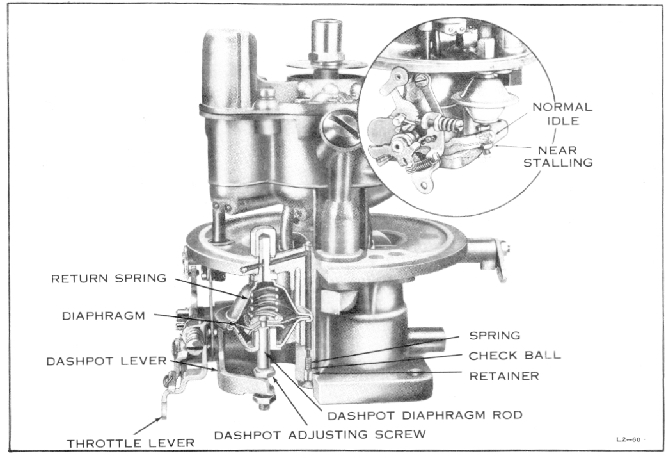
DASHPOT SYSTEM
rod of the dashpot. The tension of
the throttle
return spring, coupled with the force
of high mani
fold vacuum transmitted through the
dashpot pas
sage in the throttle body to the
dashpot diaphragm,
compresses the dashpot rod. The
remaining few
degrees of throttle plate travel
are slowed to a
rate governed by the amount of air
bleeding out
of the dashpot through the small
air bleed in the
dashpot passage check valve retainer
in the throttle
body.
If the accelerator pedal is again
suddenly de
pressed, the dashpot lever will
move downward,
away from the dashpot rod. The dashpot
return
spring will move the rod downward.
However, the
small air bleed in the dashpot passage
check valve
retainer will not allow a sufficient
flow of air into
the dashpot to allow the rod to
immediately return
to the extended position. During
this period, mani
fold vacuum will be weak, due to
the suddenly
opened
throttle plates. The dashpot return
spring, pressing
downward on the diaphragm, creates
a vacuum in the
dashpot passage to draw the check
valve ball off its
seat, thus presenting a large opening
through which
prepare for repeated sudden deceleration.
When the engine is at idle, the
dashpot rod is
held up, compressing the dashpot
return spring. The
tension of the throttle return spring
acting through
the dashpot lever and high manifold
vacuum metered
through the bleed in the check ball
retainer to the
dashpot diaphragm hold the rod in
this position. If
the engine begins to stall, manifold
vacuum will
drop. When this occurs, the vacuum
trapped in the
dashpot passage lifts the check
ball. This weakens
the vacuum in the dashpot passage
and the tension of
the compressed dashpot return spring
forces the
dashpot stem down to open the throttle
plates. When
engine speed increases, manifold
vacuum acting
throughthe checkball retainer bleedbecomes
strong
enough to assist the throttle return
spring in return
ing the dashpot rod to its original
position. As the
dashpot rod returns to this position,
the throttle
plates close to the idle position.
The check ball in
the dashpot passage is held against
its seat by a
spring in earlier models of this
carburetor. In lat
ter models, the check ball, spring,
and retainer are
built into the top of the dashpot
itself. This type of
dashpot is also used as a service
replacement unit
